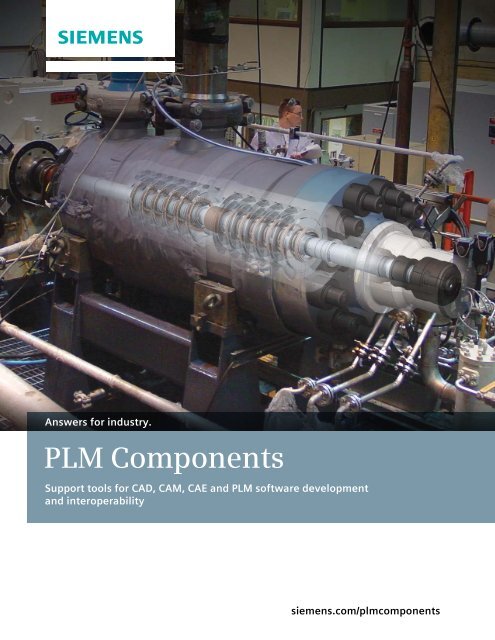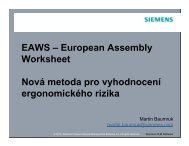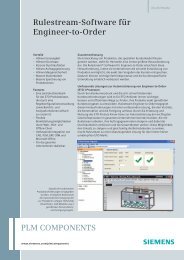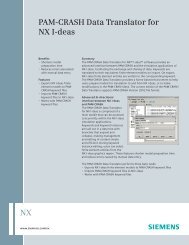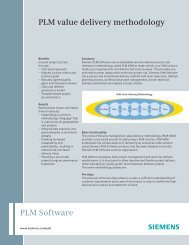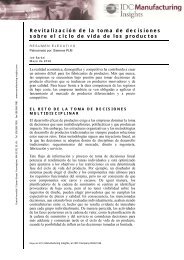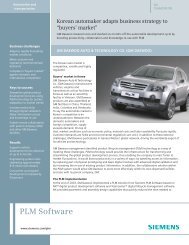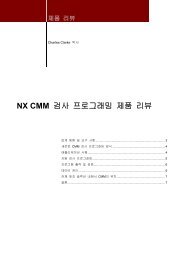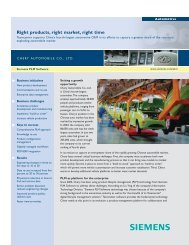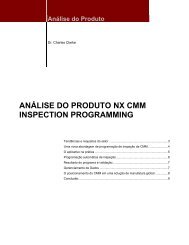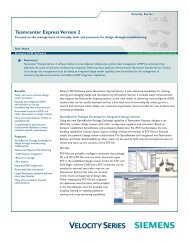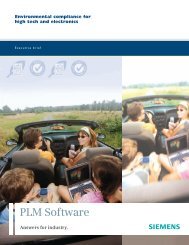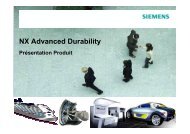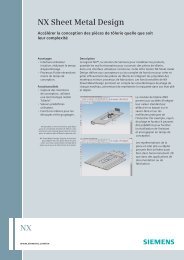PLM Components Brochure - Siemens PLM Software
PLM Components Brochure - Siemens PLM Software
PLM Components Brochure - Siemens PLM Software
Create successful ePaper yourself
Turn your PDF publications into a flip-book with our unique Google optimized e-Paper software.
Answers for industry.<br />
<strong>PLM</strong> <strong>Components</strong><br />
Support tools for CAD, CAM, CAE and <strong>PLM</strong> software development<br />
and interoperability<br />
siemens.com/plmcomponents
Business challenges<br />
<strong>Siemens</strong> is proud to offer several<br />
of the product lifecycle management<br />
(<strong>PLM</strong>) industry’s most widely<br />
used open software components<br />
which are used by software developers<br />
and manufacturers worldwide<br />
to improve interoperability<br />
and productivity. <strong>PLM</strong> components<br />
reduce development time and<br />
costs, while introducing proven<br />
quality, reliability and robust<br />
functionality into specialized<br />
design environments.<br />
Throughout the global manufacturing<br />
industry, companies employ a wide array<br />
of information technology solutions<br />
designed to increase productivity, reduce<br />
costs and promote innovation at all<br />
points in the product lifecycle. Manufacturers<br />
select from a myriad of product<br />
lifecycle management (<strong>PLM</strong>) applications –<br />
in addition to developing software of<br />
their own – as they continually seek a<br />
new competitive edge that ultimately<br />
will translate into increased revenue and<br />
higher profits.<br />
Of course, it’s not easy to develop software<br />
that keeps pace with this rapidly<br />
growing and constantly changing environment.<br />
It is no longer sufficient for<br />
organizations developing <strong>PLM</strong> applications<br />
to simply solve an isolated problem<br />
or set of problems that exist along a<br />
product’s value chain. They also<br />
must ensure that their solutions seamlessly<br />
communicate with multiple applications<br />
– developed by a variety of independent<br />
organizations – in order to plug<br />
into an existing <strong>PLM</strong> system and operate<br />
efficiently across an integrated multicompany<br />
process. Independent software<br />
vendors (ISVs) in the <strong>PLM</strong> industry, as<br />
well as manufacturers with in-house<br />
software development organizations,<br />
need access to tools that:<br />
• Promote standardization<br />
• Enable seamless interoperability<br />
• Deliver robust functionality with<br />
industry-proven reliability<br />
• Enhance software quality<br />
• Reduce development time and costs<br />
To respond to all of these challenges<br />
<strong>Siemens</strong> <strong>PLM</strong> <strong>Software</strong> offers <strong>PLM</strong><br />
<strong>Components</strong>, a family of development<br />
toolkits, software components and<br />
industry initiatives employed in all of<br />
<strong>Siemens</strong>’ own industry-leading <strong>PLM</strong><br />
applications and openly available to all<br />
organizations interested in maximizing<br />
the value of <strong>PLM</strong>. Our solutions solve<br />
complex technical problems so successfully<br />
that even our competitors license<br />
our components.<br />
2
Introducing<br />
<strong>PLM</strong> <strong>Components</strong><br />
Companies that use <strong>PLM</strong> software and services<br />
to run their businesses increasingly<br />
require their suppliers and their own IT<br />
departments to provide open solutions<br />
that promote seamless interoperability and<br />
data sharing. These companies don’t want<br />
to worry about incompatible data formats<br />
and versioning problems that inhibit their<br />
ability to collaborate. They don’t want to<br />
deal with <strong>PLM</strong> suppliers whose proprietary<br />
business models prevent the implementation<br />
of a multi-vendor solution.<br />
As the world’s leading supplier of open<br />
<strong>PLM</strong> solutions, <strong>Siemens</strong> has always recognized<br />
this need and has built its business<br />
and its technology around it. As part of its<br />
pervasive <strong>PLM</strong> Open business model,<br />
<strong>Siemens</strong> builds openness into everything it<br />
does from its professional services organization<br />
to its global partnerships and alliances<br />
to its complete family of world-class<br />
<strong>PLM</strong> software products. That’s why <strong>Siemens</strong><br />
presents product offerings as open<br />
by design solutions.<br />
Consistent with this open business model,<br />
<strong>Siemens</strong>’ <strong>PLM</strong> <strong>Components</strong> suite enables<br />
any software development organization to<br />
access the same technology used in <strong>Siemens</strong>’<br />
own products on a worldwide basis.<br />
As a result, consumers of <strong>PLM</strong> technology<br />
benefit from a rapidly growing universe of<br />
suppliers offering compatible solutions<br />
that create instant value for<br />
their organizations.<br />
3
<strong>PLM</strong> <strong>Components</strong> family<br />
<strong>Siemens</strong>’ <strong>PLM</strong> <strong>Components</strong> family<br />
includes some of the industry’s most<br />
widely used component software and<br />
development toolkits, as well as industry<br />
initiatives that support and promote<br />
these open solutions. The vast majority<br />
of the world’s CAD, CAM, CAE and <strong>PLM</strong><br />
developers – including many of <strong>Siemens</strong>’<br />
competitors – rely on one or more of<br />
<strong>Siemens</strong>’ <strong>PLM</strong> <strong>Components</strong> to provide<br />
their applications with proven, robust<br />
functionality. This functionality provides<br />
customer value, while developers focus<br />
on their own unique areas of expertise.<br />
Hundreds of applications use <strong>PLM</strong><br />
<strong>Components</strong> and these applications<br />
enjoy a high level of data and functional<br />
compatibility as a result of embedding<br />
the same technology.<br />
Marketed and delivered through <strong>Siemens</strong><br />
<strong>PLM</strong> <strong>Software</strong>’s level playing field business<br />
model, the <strong>PLM</strong> <strong>Components</strong> family<br />
consists of the following solutions:<br />
• Parasolid® software – the leading<br />
production-proven 3D geometric<br />
modeling component software<br />
provides the geometry foundation for<br />
more of the world’s major CAD, CAM<br />
and CAE applications than any other<br />
solution. Complementary products<br />
include Parasolid Bodyshop, robust<br />
healing technology for imported data,<br />
and Parasolid Translators for most<br />
major CAD formats.<br />
• D-Cubed software – a suite of<br />
advanced tools for sketching, part and<br />
assembly modeling, motion simulation,<br />
collision detection, clearance<br />
measurement and hidden-line<br />
visualization. D-Cubed components<br />
provide vital functionality to most of<br />
the world’s leading CAD systems and<br />
many other applications.<br />
4
• JT Open Program – a global community<br />
organized by <strong>Siemens</strong> at the request<br />
of its customers that establishes the<br />
widely-used JT data format as the<br />
common standard for sharing product<br />
and manufacturing information in<br />
the <strong>PLM</strong> industry. JT Open members<br />
include many of the world’s leading<br />
manufacturers and <strong>PLM</strong> suppliers,<br />
along with prestigious universities and<br />
academic institutions.<br />
• <strong>PLM</strong> Vis software – enables the rapid<br />
addition of 2D and 3D visualization and<br />
collaboration functionality to custom<br />
applications and plugins. It is available<br />
as both ActiveX controls or Java beans<br />
and is 100 percent compatible with<br />
Teamcenter® visualization software.<br />
• NX Nastran® SDK software –<br />
a software development toolkit that<br />
enables commercial and private software<br />
development organizations to enhance<br />
their software development and <strong>PLM</strong><br />
applications by tapping into the power<br />
and capabilities of NX Nastran and the<br />
worldwide Nastran install base.<br />
• <strong>PLM</strong> XML – <strong>Siemens</strong>’ widely used XML<br />
schema for facilitating interoperability<br />
among <strong>PLM</strong> software implementations.<br />
<strong>PLM</strong> XML has an openly published<br />
schema that promotes high-content<br />
product lifecycle data sharing.<br />
• Geolus® Search software – is a<br />
shape-based search engine. It finds<br />
similar as well as identical shapes and<br />
it complements traditional search<br />
methods. It is architected as a web<br />
component and includes a SOAP<br />
interface that has enabled integration<br />
with products such as NX, Teamcenter<br />
and BCT’s A Class.<br />
5
Business value of <strong>PLM</strong> <strong>Components</strong><br />
Whether you work for a commercial ISV or an in-house IT<br />
development organization, you are always looking for ways<br />
to improve efficiency and maximize the value of the<br />
applications you produce. Employing <strong>PLM</strong> <strong>Components</strong><br />
helps you meet these objectives by instantly benefiting<br />
from hundreds of man years of development experience,<br />
and enabling you to create solutions based on well established,<br />
open technology. <strong>PLM</strong> <strong>Components</strong> help eliminate<br />
the data and operational incompatibilities that can act as<br />
artificial barriers to your target market.<br />
Increase customer value by focusing resources<br />
on your unique expertise<br />
An efficient, cost effective way for your organization to<br />
add customer value to your software applications is to focus<br />
your resources on the specific areas of expertise that separate<br />
you and your products from your competitors – not by<br />
spending valuable development time reproducing code<br />
that is already well established.<br />
Many of the component software tools in the <strong>PLM</strong><br />
<strong>Components</strong> family have been serving a vital role in enduser<br />
applications for years. They provide stable, robust,<br />
industry-tested functionality that works quietly behind the<br />
scenes so that you canconcentrate on the high value innovations<br />
that will help your software solutions stand<br />
out in your market.<br />
Improve quality with proven technology<br />
<strong>Software</strong> quality is critical in your efforts to keep maintenance<br />
costs low and customer satisfaction high. By using<br />
one or more of the solutions from the <strong>PLM</strong> <strong>Components</strong><br />
family, you are able to leverage the rigorous quality testing<br />
for which <strong>Siemens</strong> is known. You also will experience the<br />
peace of mind that comes from knowing you are using the<br />
exact same code that is operating in hundreds of other<br />
leading commercial applications all over the world.<br />
Streamline implementation by eliminating<br />
incompatibilities<br />
In addition to ensuring robust functionality and high quality,<br />
<strong>PLM</strong> <strong>Components</strong> are focused on delivering open solutions<br />
that promote standardization and interoperability.<br />
Incorporating <strong>PLM</strong> <strong>Components</strong> into your applications can<br />
help eliminate incompatibilities with your customers’ IT<br />
environment, thereby streamlining their implementation<br />
processes. Offering open software that is easy to implement<br />
and compatible with the rest of the industry drives customer<br />
demand higher.<br />
Accelerate development and reduce your<br />
time-to-market<br />
Substantial coding and quality assurance resources have<br />
been deployed in the development of each <strong>PLM</strong> component.<br />
Our customers are able to reap the considerable benefits<br />
of these substantial investments within a typical release<br />
cycle. <strong>PLM</strong> <strong>Components</strong> will also enable your organization<br />
to bring rich functionality to market in the shortest<br />
possible time.<br />
Maximize size of potential market through<br />
open solutions<br />
While <strong>PLM</strong> <strong>Components</strong> help promote standardization<br />
and interoperability within your target markets, they also<br />
can help make your solutions appealing to new and/or<br />
expanded markets. The same instant compatibility that<br />
makes implementation easier with your traditional customers<br />
also creates compatibility – and opportunity – in rising<br />
new markets. <strong>PLM</strong> <strong>Components</strong> are utilized in hundreds of<br />
leading <strong>PLM</strong> applications which are accessed by millions of<br />
users worldwide. This large and rapidly growing crossindustry<br />
user base holds unlimited potential for your high<br />
value applications.<br />
7
Parasolid<br />
“We have been more than <br />
happy with our choice of <br />
Parasolid. Since we started <br />
using it in the early 1990s, <br />
Parasolid has continued to <br />
open up new markets and <br />
potential newusers for our <br />
products.”<br />
Don Babbs<br />
CEO<br />
Vero International <strong>Software</strong><br />
Parasolid is the world’s leading production-proven<br />
3D geometric modeling<br />
component software, providing core<br />
functionality that enables users of<br />
Parasolid-based products to rapidly<br />
and robustly model the industry’s most<br />
complex products. Based on high<br />
precision boundary-representation<br />
technology, Parasolid supports<br />
solid modeling, generalized cellular<br />
modeling and freeform surface/sheet<br />
modeling within an integrated<br />
framework.<br />
Parasolid comprehensive capabilities<br />
extend to over 800 functions that include<br />
a wealth of model creation and editing<br />
utilities such as powerful Boolean modeling<br />
operators, feature modeling support,<br />
advanced surfacing, thickening and<br />
hollowing, blending and filleting and<br />
sheet modeling. In addition, Parasolid<br />
offers extensive tools for direct model<br />
editing, including tapering, offsetting,<br />
geometry replacement and detail<br />
removal with automated regeneration<br />
of surrounding data. Parasolid also<br />
provides wide-ranging graphical and<br />
rendering support, including precise<br />
hidden-line, wireframe and drafting, as<br />
well as versatile tessellation functionality<br />
and a full suite of model data inquiries.<br />
Parasolid functionality is underpinned by<br />
configurable mechanisms that help<br />
integrate Parasolid tightly and efficiently<br />
into diverse applications.<br />
Parasolid provides the modeling<br />
foundation for hundreds of the world’s<br />
leading computer-aided design, manufacturing<br />
and engineering analysis<br />
(CAD/CAM/CAE) applications and serves<br />
as the corporate standard for <strong>Siemens</strong>’<br />
own market-leading portfolio of product<br />
lifecycle applications, providing 3D digital<br />
representation capabilities for the<br />
company’s NX, Solid Edge®, Femap<br />
and Teamcenter software solutions.<br />
Industrially proven in high-end mechanical<br />
CAD applications, the power of<br />
Parasolid is also deployed in many<br />
leading mid-range systems and enjoys<br />
widespread use in the independent<br />
CAD, CAM, CAE and visualization<br />
markets.<br />
8
The global reach of Parasolid-enabled<br />
applications spans multiple industries and<br />
has grown beyond three and a half million<br />
end users – all of whom benefit from the<br />
ability to seamlessly share geometric<br />
models through Parasolid native XT file<br />
format. Parasolid users also benefit from<br />
intrinsic, tolerant geometry processing<br />
that enables Parasolid to operate successfully<br />
with imported data of variable<br />
accuracy without loss of robustness.<br />
To further boost interoperability for<br />
Parasolid-based systems, <strong>Siemens</strong> provides<br />
complementary tools that augment<br />
Parasolid intrinsic capabilities:<br />
Parasolid Bodyshop is an add-on<br />
component that validates and optimizes<br />
the integrity and reliability of imported<br />
data using model healing and repair<br />
technology.<br />
Parasolid Translators are toolkits that<br />
facilitate high-quality data exchange<br />
between Parasolid and most major<br />
CAD formats.<br />
These technologies combine effortlessly<br />
to provide Parasolid users with the<br />
most robust interoperability platform<br />
available today.<br />
By coupling unsurpassed 3D modeling<br />
functionality with industrial-strength<br />
interoperability and proven customer<br />
support, Parasolid continues to rapidly<br />
expand its market share and enhance<br />
its position as the kernel-of-choice for<br />
powering the world’s premier product<br />
development applications.<br />
9
D-Cubed<br />
“Adige Sala selected <strong>Siemens</strong><br />
based on its ability to supply<br />
and support a broad portfolio<br />
of high quality components <br />
under its open business model,<br />
enabling us to develop a <br />
comprehensive new application<br />
rapidly for the benefit of our <br />
Lasertube customers.”<br />
Lucia Lubich<br />
Laser Applied Research Manager<br />
Adige Sala S.p.A.<br />
D-Cubed provides a family of geometric<br />
software components enable key functionality<br />
in CAD, CAM, CAE and <strong>PLM</strong><br />
applications, including sketching, part<br />
and assembly modeling, motion simulation,<br />
collision detection, clearance measurement<br />
and hidden-line visualization.<br />
Easy to integrate and compatible with<br />
a wide range of modeling systems,<br />
D-Cubed components do not require<br />
modification of an application’s data<br />
structure, making them appropriate for<br />
new and mature applications. Most of the<br />
world’s leading CAD applications include<br />
one or more D-Cubed components.<br />
D-Cubed product portfolio<br />
2D Dimensional Constraint<br />
Manager – D-Cubed 2D DCM<br />
The 2D DCM provides dimension-driven,<br />
constraint-based design functionality<br />
both in 2D applications and in the 2D<br />
variational sketches of 3D parametric<br />
modeling systems. Sketches are constructed<br />
using a wide range of dimensions<br />
and constraints to specify the location<br />
of the geometries. The design can<br />
then be rapidly modified, by dragging<br />
geometry, for example, or by entering<br />
new dimension values.<br />
Profile Geometry Manager –<br />
D-Cubed PGM<br />
The PGM is used to manage higher-level<br />
sketching operations on loops of geometry<br />
in any CAD/CAM application. The PGM<br />
improves the productivity of the end-user<br />
of sketching systems, particularly in the<br />
areas of profile offsetting and loop<br />
constraint operations.<br />
Hidden Line Manager – D-Cubed HLM<br />
The HLM rapidly computes accurate hidden-line<br />
views, engineering drawings and<br />
technical illustrations of parts and assemblies.<br />
Compatible with virtually every<br />
geometric modeler, the HLM operates in<br />
multi-CAD environments and supports<br />
combinations of exact, faceted, solid,<br />
surface, wireframe, manifold and<br />
nonmanifold parts.<br />
10
3D Dimensional Constraint Manager –<br />
D-Cubed 3D DCM<br />
The 3D DCM enables the efficient use<br />
of dimensions and constraints to position<br />
parts in assemblies and mechanisms,<br />
control the shape of parts and<br />
to produce 3D sketches. A fully threedimensional<br />
system, its support for a<br />
comprehensive range of geometry,<br />
dimensions and constraints enables<br />
designers to efficiently build, modify<br />
and animate the most demanding of<br />
assemblies and mechanisms. As a<br />
highly flexible 3D constraint solver,<br />
the 3D DCM is also used to directly<br />
specify the shape of 3D parts and is<br />
the engine behind several of the most<br />
advanced 3D sketching environments.<br />
Assembly Engineering<br />
Manager – AEM<br />
The AEM brings the realistic and<br />
interactive motion simulation of<br />
assemblies and mechanisms to the<br />
core of a CAD system. The AEM takes<br />
account of the mass properties of<br />
parts and the forces that act on them,<br />
the motion caused by a range of engineering<br />
devices and the interaction of<br />
parts as they come into contact and<br />
transmit motion. Requiring no special<br />
preparation by the end-user, the AEM<br />
saves time and money by verifying<br />
the function of virtual assemblies and<br />
mechanisms, reducing the requirement<br />
for physical prototyping.<br />
Collision Detection Manager –<br />
D-Cubed CDM<br />
The CDM detects collisions and<br />
measures clearances on assemblies<br />
and mechanisms with exceptional<br />
accuracy and speed. Compatible with<br />
any surface or solid modeler, the CDM<br />
operates on exact or faceted models.<br />
Its excellent performance supports<br />
interactive operations during the<br />
simulation of the motion of assemblies<br />
and mechanisms.<br />
11
“Internally, we exchange <br />
information between the <br />
various parts of a design <br />
using JT, even if the parts were<br />
originally developed in different<br />
CAD tools...There’s a lot of<br />
information technology infrastructure<br />
that we would have<br />
had to put into place that is<br />
now not required because of<br />
JT.This helps us improve cycle<br />
times and reduce costs.”<br />
John Jewel<br />
IT Director, Global Climate<br />
Product Groups & Engineering IT<br />
Visteon Corporation<br />
JT Open Program<br />
JT<br />
JT is the world’s most widely used 3D<br />
language for sharing product information.<br />
JT communication versatility ranges<br />
from 100 percent precision 3D product<br />
geometry, to lightweight/high-performance<br />
product visualization. This full<br />
spectrum capability of JT technology<br />
makes it possible to view and share<br />
product data, manufacturing information<br />
and interactive 3D images worldwide,<br />
in real time and throughout all phases<br />
of the product lifecycle. Thanks to its<br />
unmatched flexibility, robust functionality<br />
and proven reliability, JT is supported<br />
by more <strong>PLM</strong> applications than any other<br />
lightweight 3D data format. When combined<br />
with JT2Go, consistent 3D product<br />
information is efficiently communicated<br />
up and down the supply chain.<br />
JT2Go<br />
JT2Go is a no-cost 3D viewing product<br />
that enables companies to globally share<br />
detailed 3D product and manufacturing<br />
data using the lightweight 3D JT format.<br />
Available via Internet download, JT2Go<br />
helps streamline collaboration between<br />
manufacturers and their supply chains<br />
across all industries. JT2Go is a deployon-demand<br />
Windows-based solution that<br />
enables data sharing across heterogeneous<br />
<strong>PLM</strong> software environments utilizing<br />
existing infrastructure. JT2Go allows<br />
users to embed 3D JT data in Microsoft<br />
Office products to provide rich collaboration<br />
using standard desktop applications.<br />
Microsoft Office plug-ins enable an<br />
embedded 3D JT file to be viewed in<br />
any Microsoft Office document.<br />
12
The JT2Go viewer enables product development<br />
teams and supply chains to review<br />
drawings, view and interrogate 3D product<br />
information and collaborate in the context<br />
of complete bill-of-materials. JT2Go<br />
includes the combined benefit of using<br />
JT with <strong>PLM</strong> XML by directly reading and<br />
displaying <strong>PLM</strong> XML files with JT references.<br />
These capabilities facilitate key<br />
<strong>PLM</strong> processes, such as engineering design<br />
reviews, requests for quotation, package<br />
reviews and manufacturing tooling<br />
reviews.<br />
Membership in JT Open is available<br />
to any and all corporate user communities,<br />
as well as ISVs, academic institutions<br />
and nonprofit industry organizations.<br />
Visit www.jtopen.com for a list of<br />
JT Open program members.<br />
In addition, other participating members<br />
include companies that derive indirect<br />
value from the initiative, such as HP, Intel,<br />
Microsoft, SAP and Elysium, who are all<br />
JT Open advocates.<br />
JT Open<br />
JT Open is a unique community of<br />
software users, independent software<br />
vendors and like-minded individuals who<br />
are committed to the adoption of the JT<br />
format as the preferred technology for<br />
3D visualization, collaboration and data<br />
sharing in today’s product lifecycle<br />
management (<strong>PLM</strong>) environments.<br />
The JT Open Program provides participating<br />
members with level-playing-field<br />
access to JT technology while promoting<br />
the development of best-in-class<br />
applications offered by the program’s<br />
vendor members.<br />
13
<strong>PLM</strong> Vis<br />
<strong>PLM</strong> Vis facilitates the rapid addition of 2D and 3D<br />
view-markup capabilities to applications. <strong>PLM</strong> Vis appeals<br />
to both corporate end-users and independent software<br />
vendors (ISVs).<br />
<strong>PLM</strong> Vis enables:<br />
• Viewing, interrogation, and markup of nearly every<br />
popular 2D format as well as JT (3D), NX, Solid Edge<br />
and Parasolid XT data in a single environment<br />
• Portable architecture – Java beans and ActiveX controls<br />
• Rapid development of custom visualization solutions<br />
through the use of building blocks<br />
• Seamless real-time internet and intranet collaboration<br />
• Extending the value and reach of 2D and 3D intellectual<br />
property across the enterprise<br />
• Broadening the scope of product data through the<br />
use of <strong>PLM</strong> XML<br />
Scalable product portfolio<br />
<strong>PLM</strong> Vis Base, <strong>PLM</strong> Vis Standard and <strong>PLM</strong> Vis Pro represent<br />
successive levels of functionality and a natural upgrade<br />
path. At each service level, <strong>PLM</strong> Vis will interpret visualization<br />
data and automatically generate graphical output in a<br />
standard pane yet still support custom mouse interrupts,<br />
selection and colors.Functionality highlights include:<br />
<strong>PLM</strong> Vis Base provides basic viewing of 3D JT data and viewmarkup<br />
on almost all the standard 2D data formats. Printing<br />
as well as viewing is supported and much of the data can<br />
be exported in alternative formats.<br />
<strong>PLM</strong> Vis Standard provides base functionality plus the ability<br />
to import 3D JT data, NX and Parasolid XT parts. Other 3D<br />
formats supported include STL and VRML data. It supports<br />
view capture, model navigation, and rubber band selection.<br />
<strong>PLM</strong> Vis Pro provides standard functionality plus assembly<br />
editing, 3D measurement, markup and compare, session<br />
save and load, animation and motion playback, plus 3D<br />
export to VRML.<br />
Even within these service levels there is a finer level of<br />
granularity ensuring that each <strong>PLM</strong> Vis application has as<br />
small a footprint as possible. This is especially important<br />
with lightweight applications that are downloaded over<br />
the web or are massively deployed throughout an<br />
enterprise or along a supply chain.<br />
Corporate end-users<br />
A company’s in-house processes reflect the company.<br />
The way it operates and implements processes differentiate<br />
it from the competition. These processes contribute to<br />
quality control, communications between departments,<br />
shave precious production minutes or enable management<br />
to keep a finger on the pulse. Companies often develop<br />
software applications to support<br />
such processes.<br />
<strong>PLM</strong> Vis is the component that adds a graphical<br />
capability to the targeted functionality developed<br />
in-house. Developing software in-house from the ground<br />
up to support company practices can be daunting.<br />
However, <strong>PLM</strong> Vis is architected as a suite of high-level<br />
building blocks that makes producing applications quite<br />
painless. Customized viewing can be added to in-house<br />
developed applications or to web browsers such as<br />
Internet Explorer.<br />
Independent software vendors<br />
ISVs use <strong>PLM</strong> Vis either because it enables them to focus<br />
on their area of core competence and import the already<br />
existing view-markup and collaboration functionality of<br />
<strong>PLM</strong> Vis or they use it because <strong>PLM</strong> Vis offers support for<br />
new file formats. <strong>PLM</strong> Vis often eases the adoption of the<br />
ISV technology into an enterprise.<br />
Increased ROI<br />
<strong>PLM</strong> Vis’ support for so many formats has enabled a number<br />
of customers to extend the reach of their data in the<br />
enterprise.<br />
“The <strong>Siemens</strong> <strong>PLM</strong> Vis toolkit helped us save time <br />
by not having to reinvent the wheel for view-markup<br />
technology. We were able to better utilize resources<br />
and produce a better product utilizing <strong>PLM</strong> <br />
Vis technology.”<br />
Rob McNiff<br />
VP Development<br />
Visiprise<br />
15
NX Nastran SDK<br />
Nastran provides the world’s most widely<br />
used and highly respected software<br />
applications for engineering simulation<br />
and analysis. For the past 40 years,<br />
companies and industries have relied on<br />
this extremely advanced tool as a critical<br />
part of their engineering infrastructure.<br />
The NX Nastran SDK is the software<br />
development toolkit that enables<br />
engineering and IT departments to<br />
openly and fully access the power and<br />
functionality of NX Nastran (the Nastran<br />
implementation from <strong>Siemens</strong>) to maximize<br />
the value of simulation. In addition,<br />
ISVs can use NX Nastran SDK to leverage<br />
the power of NX Nastran in best-in-class<br />
applications. <strong>Siemens</strong> is committed to<br />
extend the Nastran legacy of providing<br />
the premier tool for high-performance<br />
analysis of complex, global models.<br />
16
<strong>PLM</strong> XML<br />
Every year, the global manufacturing<br />
industry spends billions of dollars trying<br />
to achieve interoperability among applications<br />
used in the conception, development,<br />
engineering, manufacturing and<br />
maintenance of products. To gain significant<br />
cost savings and deliver important<br />
time-to-market advantages, the global<br />
market now demands unprecedented<br />
levels of interoperability among <strong>PLM</strong><br />
software applications. These new levels<br />
of interoperability are intended to help<br />
accelerate the execution of product<br />
development process threads. As a result,<br />
initiatives to improve interoperability in<br />
heterogeneous application environments<br />
are vitally important.<br />
<strong>PLM</strong> XML is a format created by <strong>Siemens</strong><br />
to facilitate product lifecycle interoperability<br />
using XML. It is provided as an openly<br />
published schema that complies with<br />
the World Wide Web Consortium (W3C)<br />
XSD schema recommendation.<br />
Representing a variety of product data<br />
both explicitly and via references, <strong>PLM</strong><br />
XML provides a lightweight, flexible mechanism<br />
for transporting high-content product<br />
data. <strong>PLM</strong> XML schemas are the basis<br />
of a rich interoperability pipeline that<br />
connects <strong>Siemens</strong> products and third-party<br />
applications. <strong>PLM</strong> XML complements existing<br />
and emerging standards represented<br />
in XML; it supports workflows requiring<br />
application integration, interoperability<br />
and data sharing by improving collaboration<br />
efficiency throughout the product<br />
lifecycle.<br />
<strong>PLM</strong> XML enables collaborating teams<br />
to work in ways that accommodate realworld<br />
situations such as <strong>PLM</strong> implementations<br />
consisting of multiple systems that<br />
are required to share data frequently.<br />
By providing an extensible definition and<br />
the ability to reference attached data from<br />
other systems, such as CAD and JT,<br />
<strong>PLM</strong> XML enables a comprehensive data<br />
sharing capability.<br />
17
Geolus<br />
One very valuable way of improving<br />
efficiency is by not doing work that has<br />
been done before. The earlier in the <strong>PLM</strong><br />
lifecycle we identify a proposed duplicate<br />
effort, the greater the savings. The<br />
conventional way to look for duplicate<br />
work is through matching the metadata<br />
associated with a part or process.<br />
However, there are many reasons<br />
why such a search will not be exhaustive:<br />
• An engineer is working on a<br />
“new” product with no references<br />
to past work<br />
• The company has grown through<br />
acquisition and has not unified<br />
legacy records<br />
• Progressive management has<br />
introduced improved naming<br />
conventions for the future that<br />
leave past projects behind<br />
• Different departments in different<br />
locations work differently<br />
• Past designs are “cast in concrete”<br />
with no means to follow new<br />
classification procedures<br />
The one characteristic guaranteed to be<br />
shared by two similar parts is shape.<br />
Geolus Search is a shape-based search<br />
engine. It finds similar as well as identical<br />
shapes and it complements traditional<br />
search methods. It is architected as a<br />
web component and includes a SOAP<br />
interface that has enabled integration<br />
with products such as NX and<br />
Teamcenter.<br />
Geolus unlocks the intellectual property<br />
hidden in the enterprise. How valuable<br />
would it be to cross-reference records<br />
of procurement, process planning,<br />
digital validation where the pivot criteria<br />
is the shape of the part? Geolus facilitates<br />
part and process re-use and also standardization,<br />
the best-practice that combats<br />
inventory creep.<br />
18
World-class <strong>PLM</strong> software needs<br />
open, world-class components<br />
If you or your company develops software<br />
used anywhere in the product lifecycle<br />
process, you know how aggressive your<br />
customers are, not to mention your<br />
competitors. An application that helps a<br />
company reduce product design time,<br />
cut manufacturing costs or improve innovation<br />
will definitely get people’s<br />
attention.<br />
However, if the application can’t easily<br />
share data with the user’s existing system<br />
or if you can’t get your application to<br />
market before your competitor, you may<br />
never realize the full potential of your own<br />
unique expertise. Leveraging the proven<br />
capability,widespread adoption and open<br />
design of <strong>Siemens</strong>’ <strong>PLM</strong> <strong>Components</strong> not<br />
only ensures your applications’ ability to<br />
interoperate seamlessly in the most<br />
diverse <strong>PLM</strong> environments, but enables<br />
you to develop your applications in the<br />
least amount of time with the highest level<br />
of functionality and quality.<br />
<strong>PLM</strong> <strong>Components</strong> let you focus on what<br />
you do best and provide the peace of mind<br />
that goes along with knowing your applications<br />
contain the same underlying<br />
foundation and open data formats used in<br />
all of <strong>Siemens</strong>’ applications – as well as<br />
applications developed by leading organizations<br />
all over the world. The use of <strong>PLM</strong><br />
<strong>Components</strong> helps remove artificial<br />
obstacles to your success.<br />
Before you write another line of code,<br />
call <strong>Siemens</strong> <strong>PLM</strong> <strong>Software</strong> and explore<br />
how using open, world-class component<br />
software can help enhance your<br />
world-class applications and learn why<br />
we say <strong>Siemens</strong> <strong>PLM</strong> <strong>Software</strong> solutions<br />
are open by design. Additional<br />
product information can be found at:<br />
www.siemens.com/plmcomponents.<br />
19
<strong>Siemens</strong> Industry <strong>Software</strong><br />
Headquarters<br />
Granite Park One<br />
5800 Granite Parkway<br />
Suite 600<br />
Plano, TX 75024<br />
USA<br />
+1 972 987 3000<br />
Fax +1 972 987 3398<br />
Americas<br />
Granite Park One<br />
5800 Granite Parkway<br />
Suite 600<br />
Plano, TX 75024<br />
USA<br />
+1 800 498 5351<br />
Fax +1 972 987 3398<br />
Europe<br />
3 Knoll Road<br />
Camberley<br />
Surrey GU15 3SY<br />
United Kingdom<br />
+44 (0) 1276 702000<br />
Fax +44 (0) 1276 702130<br />
Asia-Pacific<br />
100 How Ming Street<br />
Suite 4301-4302, 43F<br />
Two Landmark East Kwun Tong<br />
Kowloon<br />
Hong Kong<br />
+852 2230 3333<br />
Fax +852 2230 3210<br />
About <strong>Siemens</strong> <strong>PLM</strong> <strong>Software</strong><br />
<strong>Siemens</strong> <strong>PLM</strong> <strong>Software</strong>, a business unit of the <strong>Siemens</strong><br />
Industry Automation Division, is a leading global provider<br />
of product lifecycle management (<strong>PLM</strong>) software and<br />
services with seven million licensed seats and 71,000<br />
customers worldwide. Headquartered in Plano, Texas,<br />
<strong>Siemens</strong> <strong>PLM</strong> <strong>Software</strong> works collaboratively with<br />
companies to deliver open solutions that help them<br />
turn more ideas into successful products. For more<br />
information on <strong>Siemens</strong> <strong>PLM</strong> <strong>Software</strong> products and<br />
services, visit www.siemens.com/plm.<br />
© 2012 <strong>Siemens</strong> Product Lifecycle<br />
Management <strong>Software</strong> Inc. All rights<br />
reserved. <strong>Siemens</strong> and the <strong>Siemens</strong><br />
logo are registered trademarks of<br />
<strong>Siemens</strong> AG. D-Cubed, Femap,<br />
Geolus, GO <strong>PLM</strong>, I-deas, Insight,<br />
JT, NX, Parasolid, Solid Edge,<br />
Teamcenter, Tecnomatix and Velocity<br />
Series are trademarks or registered<br />
trademarks of <strong>Siemens</strong> Product Lifecycle<br />
Management <strong>Software</strong> Inc. or<br />
its subsidiaries in the United States<br />
and in other countries. All other<br />
logos, trademarks, registered trademarks<br />
or service marks used herein<br />
are the property of their respective<br />
holders.<br />
6920-X15 10/12 A


